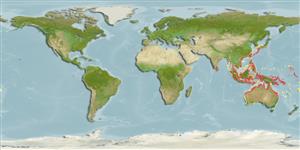Common names from other countries
Classification / Names / Names
Namen | Synonyme | Catalog of Fishes (gen., sp.) | ITIS | CoL | WoRMS
Environment: milieu / climate zone / depth range / distribution range
Ökologie
; brackwasser. Tropical
Indo-West Pacific: from India to Vanuatu; north to southern islands of Japan, and south to Queensland and New Caledonia.
Length at first maturity / Size / Gewicht / Alter
Maturity: Lm ? range ? - ? cm Max length : 10.5 cm SHL Männchen/unbestimmt; (Ref. 348); common length : 7.0 cm SHL Männchen/unbestimmt; (Ref. 348)
Widely collected as food in Asia (Ref. 348). Found in intertidal areas in mangrove mud (Ref. 75831, 85174). Also in fresh and brackish waters of mangrove swamps, estuaries, and larger rivers. Highly tolerant to surface desiccation of its habitat; can survive by aerial respiration at the posterior mantle margin for a period of a few days, and feed from subterranean water by means of water exchange through a narrow anterior gape of valves (Ref. 345).
Life cycle and mating behavior
Geschlechtsreife | Fortpflanzung | Ablaichen | Eier | Fecundity | Larven
Members of the class Bivalvia are mostly gonochoric, some are protandric hermaphrodites. Life cycle: Embryos develop into free-swimming trocophore larvae, succeeded by the bivalve veliger, resembling a miniature clam.
Poutiers, J.M. 1998. (Ref. 348)
IUCN Rote Liste Status (Ref. 130435)
CITES Status (Ref. 108899)
Not Evaluated
Not Evaluated
Bedrohung für Menschen
Harmless
Nutzung durch Menschen
| FishSource |
Tools
Internet Quellen
Estimates based on models
Widerstandsfähigkeit
hoch, Verdopplung der Population dauert weniger als 15 Monate. (K=0.76).
Verwundbarkeit
Low vulnerability (10 of 100).
Preiskategorie
Unknown.
